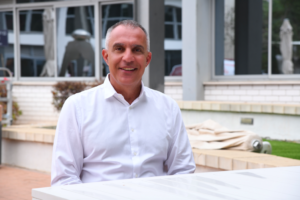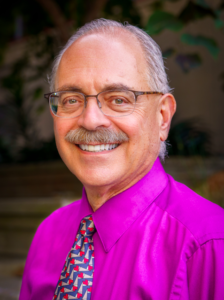By Jacob Kamaras
LA JOLLA, California — From widespread layoffs to Silicon Valley Bank’s collapse, the technology sector is not exactly a portrait of stability in this moment.
But from a long-term perspective, for entry-level tech professionals and particularly those graduating from engineering programs, the future job market may not be as bleak as it seems.
The Bureau of Labor Statistics projects that the shortage of engineers in the U.S. will exceed 1.2 million by 2026, presenting a ripe opportunity for young engineers who are entering the workforce. Meanwhile, Elon Musk’s announcement in February that Tesla would return its global engineering headquarters to California indicates that the potential for job creation in the tech professions still exists in the Golden State.
But are academic programs in engineering adequately prepared to meet the workforce’s needs when employers come calling?
The process of curricular transformation

Prof. Ami Moyal, president of Afeka – Tel Aviv Academic College of Engineering in Israel, will be visiting San Diego for the ASU+GSV Summit in April. He affirms that “the educational process of the engineer cannot remain the same. If we remain the same, we may become irrelevant.”
In that regard, he believes Afeka College’s process of curricular transformation presents a replicable model for American engineering programs.
The Israeli institution adapted the same engineering design methodology used in the high-tech industry to develop products, with the goal of transforming its engineering education process. That approach, according to Moyal, is based on the six main principles of the engineering design process — ask, imagine, plan, create, experiment, and improve.
Afeka College assessed existing survey research in the U.S. which conveyed the skills that the engineering industry expects from its graduates, then followed up by surveying 103 high-tech companies in Israel on that subject. It took the college about two years to define its strategy, a journey that also included visiting engineering institutes around the world to study their approaches.
The result, Moyal explains, was a “graduate profile” — a definition of the ultimate engineer graduating from Afeka College. This profile encompasses scientific and engineering knowledge, engineering skills, personal skills, ethics, languages, and general knowledge.
“We are completely changing the whole educational process in order to achieve the goal, or graduate profile, that we have defined,” Moyal says, noting that the college has increased project-based learning and extracurricular activities, bolstered its ties with industry and government, and embedded clear learning outcomes in its courses.
UC San Diego embarked on curricular change five years ago with its launch of the Experiential Engineering Initiative, which has brought “hands-on experiences into a school known for its exceedingly strong grasp of theory,” Pisano says. This included establishing a “maker studio” in conjunction with the university’s arts and humanities departments, introducing laboratory components into more courses, and offering new computer science classes in which students build an actual computer or system “so that you know what you’re programming for,” he says.
One new course, “Problem-Solve Like an Expert,” has aimed to build a pipeline of students who can embrace engineering education’s increasingly hands-on mentality once they reach college — helping high school students and teachers gain critical thinking skills.
Can a ‘socio-technical’ approach help meet the tech economy’s growing needs?

Albert P. Pisano, Ph.D., dean of University of California, San Diego’s Jacobs School of Engineering, notes that California is an “engineering debtor state” that imports engineers from elsewhere to fill employment gaps.
“The schools, no matter how hard they try, keep growing, but can never quite fill the needs,” he says.
Between Fall 2010 and Fall 2022, the Jacobs School’s enrollment rose from 5,872 to 9,617 — and yet, Pisano says the “demand for student talent is voracious.”
“We’re just seeing a very strong U.S. technology economy that keeps growing and grows faster, and the schools are trying to increase their enrollments,” Pisano says. “I think it’s a moving target game. Every time we grow, the tech economy grows bigger, and we’re always slightly behind.”
Susan Lord, Ph.D., chair and professor in the Integrated Engineering department at University of San Diego’s Shiley-Marcos School of Engineering, believes that preparing students to fill needs in the modern workforce means training them how to solve “problems that are more messy, more open-ended, more multidisciplinary.”
“We’re helping students see the idea that engineering is done by, for, and with people, and so it is really important to understand the context in which the technical is being done,” Lord says. “We’ve seen that with COVID, we’ve seen it with climate change, where the technical is not everything, we need to understand the context. In our department we try very hard to help students see that larger context and see engineering as socio-technical — it’s the technical that’s situated in the social environment and economic context, and we really need to help our students to see all those pieces.”
She also cites the need to “change the culture of engineering so that it’s something more people feel they could do, something they’d be welcomed to do, something they’d be interested in doing. So, the socio-technical aspect appeals to a broader slice of people, where they might want to do things where they feel like they’re going to make a difference in the world.”
For instance, Lord says USD’s curriculum has unpacked the implications of real-world scenarios such as how often it is actually necessary to purchase a new cell phone.
“When you look at the impact it has on the lives of people, say, in the Democratic Republic of the Congo, do you really need a cell phone every year? Or could you go on with the one you have a little bit longer?” she says. “There are ethical questions we can get students to address that are very meaningful to them …This generation of students is a lot more interested in, ‘How do I address some of these large problems that are looming right in front of me?’”
Pisano views engineering’s approach to problem-solving as “a means to an end.”
“What’s the real end? The end is to develop technology that makes people happier and healthier in the future,” he says. “It’s our view of the new digital world. When you look at it that way, you say, ‘Yes we have lots of problems to solve,’ but you have to back up and decide what is the right problem to solve, and if you solve it, will people or the market take it up, adopt it; can you implement it in a way that mitigates side effects?”
Cultivating diversity
The workforce’s shortage of engineers also stems from how the field “for a very long time attracted only a narrow slice of the population” that is white and male, Lord says.
In the past, engineering education has assumed that “if we can just explain to women and students of color what engineering is, then they would come and join us,” she says. “The problem is that the needle hasn’t really moved very much on the percentages of women and people of color in engineering over many decades.”
Yet Lord’s current sophomore class at USD includes an equal number of men and women — something “that is unheard of in engineering for the most part,” she says. USD’s engineering student body as a whole is approximately 30% female, nearly double the national average.
Afeka College, too, has doubled its proportion of female students from 15% to 30% in the past decade. Moyal says the trend of women’s lagging interest in engineering and other STEM disciplines is rooted in perception. He says this perception can change if women increasingly work with technology like computers and robots from as early as kindergarten, and if they interact with more female role models in the tech professions.
Pisano explains that diversity also has a neurological component.
“Different people learn different ways,” he says. “Some people are visually oriented, some people are texturally oriented, some people are hands-on. You can’t just play the engineering playbook from 30 years ago, which says, ‘If you can’t make a 3D sketch, you’re not an engineer. You can’t draw, so give it up.’”
California’s environmental focus
Given the “deep-seated awareness of climate change” in California, Lord says, engineering students “see all this solar energy and they’re very interested in working in that.” USD responded by transforming the traditional thermodynamics for sophomores, which previously centered on the thermodynamics of a coal-fired power plant.
“[Previously, students would] learn about the fossil fuel way of generating power, and then if they had time, they’d go take some alternative energy thing later. I do think in California in particular we need to flip that around,” Lord says. “The course that everyone needs to take is the one around renewable energy, solar, and wind, since those are part of our mix here, and then if there’s time they can go take the fossil fuel course.”
Pisano echoes that “California is a state that’s very concerned about the environment. Even if they’re cheaper, we don’t allow ourselves to use technologies that negatively impact the environment… What does an engineering school do about that? Our job is to work on the technologies that can be implemented in a way so that they don’t have to be expensive and still not have that deleterious effect.”
UC San Diego is pursuing research projects that focus on the decarbonization of industries (reducing carbon dioxide emissions) and even carbon-negative manufacturing — an industrial process that would consume more carbon than it produces.
Eyeing the future
Where does engineering education go from here? Lord says the necessary paradigm shift is illustrated by different marketing campaigns launched by the National Academy of Engineering. One reached out to young women of color with the tagline, “It’s hard but it’s worth it.” The other asserted, “Engineering can make a world of difference.”
“Can we change the way we talk about engineering, the way we teach engineering, the way we do engineering, so that we’re focused on making a difference in the world, not just staying up all night and solving problems?” she says.
Moyal envisions change-oriented engineering institutes participating in a multi-year partnership that entails sharing data, case studies, and stories of successes and failures — helping them “accelerate the rhythm of change.”
Ultimately, as Pisano sees it, “You just can’t educate enough engineers.”
*
Preceding republished from Times of San Diego, with which San Diego Jewish World trades stories under auspices of the San Diego Online News Association.